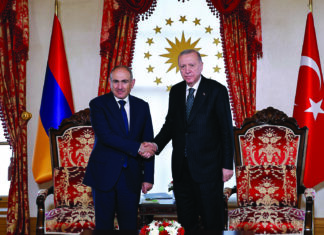YEREVAN/PARIS — Dancer and choreographer Aline Derderian was born in Marseille. Graduating with a BA (with honors) in performance design and practice from the Central Saint Martins University of the Arts in London, Derderian spent a year in Paris studying dance. In 2016, she received the Leverhulme Grant for the Arts enabling her to pursue her path for an MFA in the choreography program at Trinity Laban Conservatoire of Music and Dance. Many trips to the United States and Armenia created a vivid wish to connect her performance art background, Armenian roots and postmodern dance influences in order to develop a choreographic process that questions and challenges the archetypal female dancing body as a catalyst for contemporary feminine performance writing and cultural survival.
Currently on her third year of a PhD thesis at Rennes 2 University supervised by Marie-Noëlle Semet-Haviaras, Derderian is exploring innovative ways to envision a feminist historiography of dance through the lens of postmodern choreographer Anna Halprin, Southern California feminist activist performance art pedagogy, and Armenian female artists in diaspora.
An associate lecturer at Central Saint Martins from 2016 to 2020, Derderian taught as an associate lecturer/tutor in set design for dance and choreography at the occasion of modules such as Dance Lab or Design for Dance in collaboration with Rambert School of Contemporary Dance & Ballet, Central School of Ballet and London Studio Centre. Aline currently choreographs, dances and performs with the company Consensus & Aline Derderian, she founded in 2014 and teaches choreography on the Fine Arts department of Rennes 2 University. Dance works include performances for Bouchra Ouizguen, Mette Sterre, Anatalovi Vlassov, Scatter Dance Company, Dimitra Petsa and Corinne Lansell, among others.
Aline, you both dance and direct, also design costumes for your choreography. This is something that female dancers often do. Have you ever heard about a male dancer who designs his own stage costumes?
Absolutely. When entering Central Saint Martins’ Performance: Design & Practice BA course, I had the chance to be immersed in an environment where the majority of students shared a common interest in both set design/costume making and performing arts regardless of our gender. For my peers and I the creation of a choreographic piece and its efficacy always relied in how these design factors interacted with our dances and the dancers’ physicality. Saul Nash, Londoner break-dancer and choreographer for example, ended up joining a fashion course that allowed him to mix his performing background to his menswear fashion interests. He now owns his own brand, SSAN, and gets to choreograph the presentations of his collections.
Jasper Winn says that dancing is all about wordless communication. But oral speech seems to be often present in your work. When does body language become not enough?









